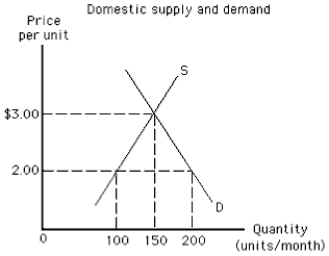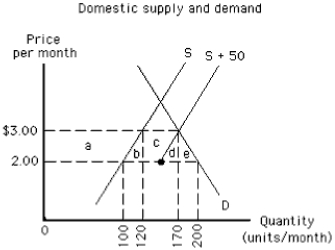Correct Answer

verified
Correct Answer
verified
Multiple Choice
As a result of international trade,
A) the gain to producers in the importing country exceeds the loss to consumers in the importing country
B) the loss to producers in the importing country is less than the gain to consumers in the importing country caused by a decrease in price
C) the loss to producers in the importing country exceeds the gain to consumers in the importing country caused by an increase in price
D) the loss to producers in the importing country is equal to the gain to consumers in the importing country because price increases and equilibrium quantity decreases
E) the loss to producers in the importing country is equal to the gain to consumers in the importing country because price decreases and equilibrium quantity increases
Correct Answer

verified
Correct Answer
verified
Multiple Choice
U.S.auto workers sometimes experience structural unemployment because of the popularity of foreign cars.Which argument is a labor union most likely to present to Congress when it lobbies for trade restrictions?
A) national defense argument
B) infant industry argument
C) antidumping argument
D) loss of domestic jobs argument
E) declining industry argument
Correct Answer

verified
Correct Answer
verified
Multiple Choice
International trade does all the following except
A) allow a country to specialize in producing certain goods and services
B) reduce world output
C) allow a country to move to a higher consumption possibilities frontier
D) allow a country's consumption possibilities frontier to lie outside its production possibilities frontier
E) increase world output
Correct Answer

verified
Correct Answer
verified
Multiple Choice
Which of the following is not true regarding the argument for protection as a way of maintaining jobs and wage levels?
A) Wages may be only a small fraction of total production costs.
B) High wages do not necessarily imply high labor costs when productivity is taken into account.
C) U.S.workers are among the most productive in the world partly because they are well educated and trained compared to other countries.
D) U.S.workers are highly productive partly because they are provided with abundant supplies of machines and physical capital.
E) It is not possible that the U.S.wages,even when supported by high U.S.output per worker,can render U.S.products competitive with low-wage countries.
Correct Answer

verified
Correct Answer
verified
Multiple Choice
Exhibit 19-5  -Suppose that the world price in Exhibit 19-5 is $2.00 per unit.What is the smallest import quota that would not affect the level of imports in this country?
-Suppose that the world price in Exhibit 19-5 is $2.00 per unit.What is the smallest import quota that would not affect the level of imports in this country?
A) $3.00
B) $2.00
C) 50 units per month
D) 100 units per month
E) 150 units per month
Correct Answer

verified
Correct Answer
verified
Multiple Choice
The international treaty established to negotiate lower trade restrictions is known as the
A) World Bank Act
B) General Agreement on Tariffs and Trade (GATT)
C) International Association for Free Trade (IAFT)
D) Countries United for Free Trade (CUFT)
E) International Development Fund
Correct Answer

verified
Correct Answer
verified
Multiple Choice
Exhibit 19-7  -If the country in Exhibit 19-7 is initially trading without restrictions at a world price of $2.00 and an import quota of 50 units per month is enacted,the decrease in consumer surplus can be represented by area
-If the country in Exhibit 19-7 is initially trading without restrictions at a world price of $2.00 and an import quota of 50 units per month is enacted,the decrease in consumer surplus can be represented by area
A) a
B) c + d
C) c + d + e
D) b + c + d + e
E) a + b + c + d + e
Correct Answer

verified
Correct Answer
verified
Multiple Choice
Which of the following is true?
A) International trade makes it possible for a country's consumption possibilities to exceed its production possibilities.
B) International trade requires that a country's production possibilities exceed its consumption possibilities.
C) A country's production possibilities always equal its consumption possibilities.
D) A country's consumption possibilities can never equal its production possibilities because of leakages in the system.
E) As long as there is full employment of resources,a country's production possibilities will exceed its consumption possibilities even with trade.
Correct Answer

verified
Correct Answer
verified
Multiple Choice
International trade is most likely to occur whenever
A) one of the trading nations is self-sufficient
B) all of the trading nations are self-sufficient
C) one of the trading nations gains from trade
D) each of the trading nations gains from trade
E) labor is cheaper abroad
Correct Answer

verified
Correct Answer
verified
Multiple Choice
A nation's consumption possibilities frontier is
A) always the same as its production possibilities frontier
B) never the same as its production possibilities frontier
C) the same as its production possibilities frontier only if there is advantageous trade
D) the same as its production possibilities frontier only if there is no international trade
E) usually lower than its production possibilities frontier
Correct Answer

verified
Correct Answer
verified
True/False
It is possible for one country to have a comparative advantage in the production of all products.
Correct Answer

verified
Correct Answer
verified
Multiple Choice
The establishment of GATT resulted in
A) lower tariff rates
B) increased tariff rates
C) decreases in total world trade
D) increased protectionism
E) a rise in the price of imports
Correct Answer

verified
Correct Answer
verified
Multiple Choice
In New Zealand one worker can produce 40 walking sticks or 10 boomerangs each hour.What is the opportunity cost of producing one walking stick?
A) 40 boomerangs
B) 10 boomerangs
C) 4 boomerangs
D) 1/4 of a boomerang
E) 1/2 worker
Correct Answer

verified
Correct Answer
verified
Multiple Choice
For each watch Denmark produces,it gives up the opportunity to make 50 pounds of cheese.Germany can produce one watch for every 100 pounds of cheese it produces.Which of the following is true concerning production possibilities curves in both countries?
A) The slopes of the countries' production possibilities frontiers cannot be determined unless the number of workers in each country is known.
B) The countries' production possibilities frontiers have the usual bowed-out shape.
C) On a graph with cheese on the vertical axis,the slope of Germany's production possibilities frontier is everywhere equal to 1/100.
D) On a graph with cheese on the vertical axis,the slope of Germany's production possibilities frontier is steeper than Denmark's.
E) On a graph with cheese on the vertical axis,the slope of Germany's production possibilities frontier is everywhere equal to negative 1/100.
Correct Answer

verified
Correct Answer
verified
Multiple Choice
For each watch Denmark produces,it gives up the opportunity to make 50 pounds of cheese.Germany can produce one watch for every 100 pounds of cheese it produces.Which of the following is true concerning comparative advantage between the two countries?
A) Denmark has the comparative advantage in watches and cheese.
B) Germany has the comparative advantage in watches and cheese.
C) Germany has the comparative advantage in watches.
D) Denmark has the comparative advantage in watches.
E) Denmark has the comparative advantage in cheese.
Correct Answer

verified
Correct Answer
verified
Multiple Choice
The losers when the United States institutes trade restrictions include
A) U.S.consumers of imported goods,U.S.producers who use imported intermediate goods,and,if other countries retaliate,U.S.exporters
B) U.S.producers of goods that compete with imported goods only
C) U.S.consumers of imported goods and U.S.producers of goods that compete with imported goods
D) all U.S.producers of all goods and U.S.exporters
E) only U.S.exporters
Correct Answer

verified
Correct Answer
verified
Multiple Choice
Tina Makumbi imports sesame oil from Ethiopia and sells to a market that has a downward sloping demand curve.The demand curve indicates that some consumers are willing to pay $1.50 or more per pound for the first few pounds,but every consumer gets to buy at the market clearing price of $0.50 per pound.The difference between the most that consumers would pay and the actual amount they do pay is called
A) exporter surplus
B) trade balance
C) producer surplus
D) consumer equilibrium
E) consumer surplus
Correct Answer

verified
Correct Answer
verified
Multiple Choice
Mutually beneficial trade will occur between two countries for all of the following reasons except one.Which is the exception?
A) The opportunity costs of producing two goods differs between the two trading partners.
B) One country is more productive than the other.
C) One country is more efficient than the other.
D) One country has an absolute advantage over the other.
E) Each country has a comparative advantage in producing some good.
Correct Answer

verified
Correct Answer
verified
True/False
U.S.consumers would be better off if they bought only U.S.-produced goods.
Correct Answer

verified
Correct Answer
verified
Showing 21 - 40 of 147
Related Exams